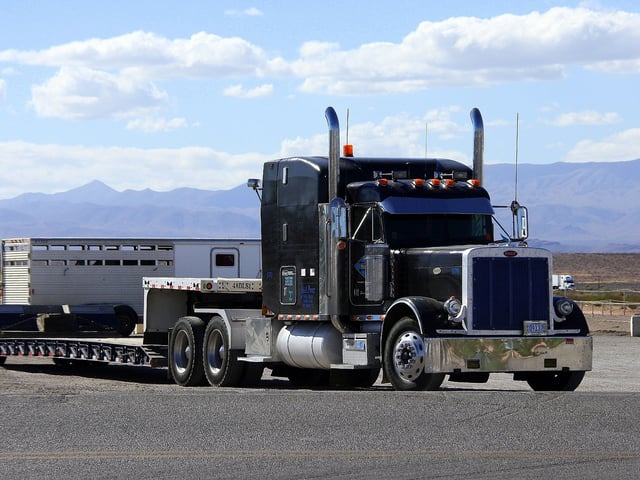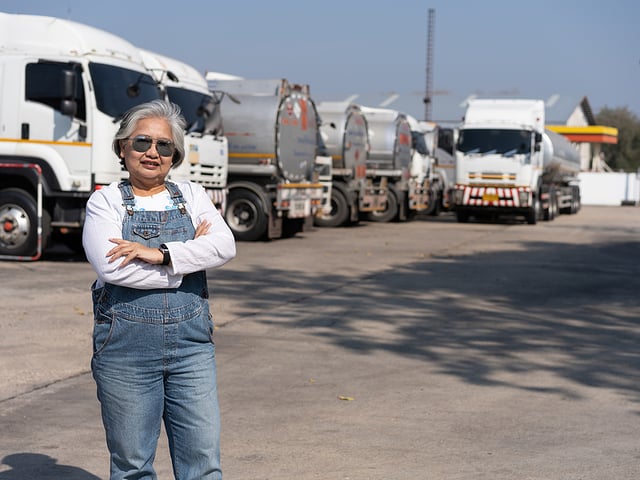
How Long Does it Take to Get a CDL?
Do you want to become a commercial trucker? The trucking industry is the U.S. economy’s beating heart, transporting nearly 3/4ths of all commercial goods.
To join this essential workforce, you need a commercial driver’s license (CDL). The CDL test proves you can safely drive and maintain large vehicles, so it covers much more ground than a typical driver’s license test.
How long does it take to get a CDL? The answer depends on several factors. We have all the information you need to get started.
What is a CDL?
A CDL is the basic licensing requirement for operating large commercial vehicles. It also applies to vehicles with heavy or hazardous freight.
This type of license isn’t limited to semi-trucks. Other commercial vehicles that require a CDL include:
-
Truck and trailer combos
-
Tankers
-
School buses
-
City and tourist buses
-
Delivery trucks
-
Dump trucks
-
Double and triple trailers
-
Hazmat vehicles
-
Livestock transport
-
Flatbeds
-
Passenger vans
The main purpose of a CDL is to improve highway safety. This license was made a federal requirement under the Commercial Motor Vehicle Safety Act of 1986. Although each state runs its own CDL program, it must meet the minimum federal requirements.
CDL standards were recently updated in February 2022. It now requires certain types of license training programs to be completed only through a Federal Motor Carrier Safety Administration (FMSCA)-approved training provider.
How to Get a CDL
There are several ways to get a CDL. Although your exact process may vary, it generally has four basic steps:
-
Going over the CDL Manual
-
Getting a Commercial Learner’s Permit (CLP)
-
Completing a CDL training program
-
Taking the official CDL test
Every state runs its own program, so your first step is finding your state’s CDL manual. This manual will be the guide to your state’s CDL process, standards, regulations, and requirements.
Your next step will be applying for a CLP. Just like a regular driver’s license permit, a CLP allows you to practice driving commercial vehicles on roads with a licensed instructor.
If you’re applying for a Class A or B license, you’ll also have to complete FMSCA’s new entry-level driver training requirements. This means your provider has to be officially approved for your training time to count.
Your last step is applying for the CDL at an official licensing provider, like a DMV. They’ll give you the state’s CDL test and determine if you pass or if you require a partial/full retest.
Getting a CDL: Factors Affecting Length of Time
There are many variables that affect how long it takes to get a CDL. You can expect anywhere between 3 weeks to 6 months. It generally averages around 7 weeks, however.
You can avoid unnecessary delays by keeping all your paperwork and training in order. This includes knowing the proper CDL classifications and endorsements you need. You should also be prepared to pass the CDL test.
1. Types of License Classifications
CDL classifications use two important calculations: the gross vehicle weight rating (GVWR) and the gross combination weight rating (GCWR). These totals are provided by the vehicle manufacturer. They’re usually found on stickers or placards somewhere on the vehicle.
The GVWR refers to the maximum weight a single vehicle is allowed. GCWR is the total maximum allowed for a combination of vehicles, such as a tow vehicle and its tow trailer.
The CDL classification you need depends on the type of vehicle you want to drive. There are three main CDL classifications:
-
Class A
-
Class B
-
Class C
Class A allows you to drive any vehicle combination with a GCWR of 26,001 lbs or higher. This includes any towed vehicles with a GVWR over 10,000 lbs. An 18-wheeler truck is an example of a Class A vehicle.
Class B is for any single vehicle with a GVWR of 26,001 lbs or higher. This also includes tows with a GVWR below 10,000 lbs. Straight trucks and box trucks are examples of Class B vehicles.
Class C lets you drive any single vehicle or vehicle combination that transports:
-
16 passengers or more
-
Hazardous material
-
Select agents or toxins
Class C also covers commercial vehicles not included under Class A and B. School buses and hazmat trucks are examples of Class C vehicles.
Generally, the Class A license requires the most amount of training time. For example, some Class A training programs may have 160 instruction hours, compared to only 120 hours for Class B.
Check with your state and truck driving school requirements to find out the training program lengths you can expect. You may even find one school offers more flexible instruction than another, allowing you to complete the program faster.
2. Driver’s License Options for Endorsements
Some commercial vehicles require special endorsements on their commercial driver’s licenses. FMCSA’s endorsement codes are:
-
T: Double/Triple Trailers
-
P: Passenger
-
N: Tank vehicle
-
H: Hazardous materials
-
X: Tank and hazmat combination
-
S: School Bus
Only three codes are allowed on the CLP: P, S, and N. Drivers with a CLP cannot operate vehicles that include actual hazmat or unofficial passengers.
Endorsements have their own separate testing requirements, so they can increase the time it takes to get a CDL. Passenger and school bus endorsements require a skills test and a knowledge test. All other codes are knowledge tests only.
3. Driver’s License Options for Restrictions
On the opposite side of endorsements, there are restrictions that can be placed on your CDL. These can include failing a benchmark or testing with vehicle limitations (i.e. no manual transmission).
FMSCA’s restrictions codes are:
-
L: Air brake restriction
-
Z: Hydraulic brake restriction
-
E: Manual transmission restriction
-
O: Fifth wheel restriction
-
M: Class A license that can only operate Class B or C passenger vehicles and school buses
-
N: Class B license that can only operate Class C passenger vehicles or school buses
These codes prohibit you from operating a commercial vehicle with the specific restriction. For example, an L restriction means you can’t legally drive a commercial truck with an air brake system.
It may add more time to get a CDL if you wish to avoid certain restrictions. Your training school may only offer automatic vehicles, for instance, resulting in an E restriction. This can affect your employment with a company that still has manual transmission vehicles.
You can also remove a restriction on your CDL, though the process may differ by state. Check with your trucking school and current/prospective employers to learn more about which restrictions can affect your CDL.
4. Training Programs and Practice
You must complete the applicable CDL training and practice requirements. The factors affecting this length of time include:
-
State standards
-
Company requirements
-
Program length
-
Class length
-
Class schedule
-
Part-time vs. full-time programs
-
Online or in-class instruction
Some schools offer training but not testing. These schools can add time since you must test somewhere else after completing the program.
Your performance and aptitude can also affect your CDL training time. Most schools understand that not everyone is used to handling large vehicles, however. If you’re unsure how well you’ll do, look for a program offering flexible pacing and additional practice time.
5. The CDL Test
The main CDL test contains a written knowledge test and a skills test, just like getting your regular driver’s license. But these tests can be much more difficult if you aren’t prepared.
There are seven individual knowledge test sections:
-
A general knowledge test
-
The 5 endorsement tests
-
An air brakes system test
You may not have to take all seven tests depending on your state requirements and the type of endorsements you need. Additionally, you can only take the knowledge test portion in your state of residency.
The skills portion covers three main areas:
-
Vehicle inspection test
-
Basic control skills test
-
Driving road test
The required documents you must submit also vary by state. These are usually similar to the documents required for a regular driver’s license, including:
-
Photo ID
-
Social Security card
-
Applicable medical documents (vision tests, hearing tests, etc.)
-
Proof of state residency
-
Proof of U.S. citizenship or lawful residence
-
Insurance cards
You may also need documents specific to your CDL. The hazmat endorsement, for example, requires a Federal Security Threat Assessment. Not having all the required documents in order and ready to go can delay getting your CDL.
Passing the CDL Test
If you’re itching to hit the road already, you don’t want the CDL test to be the last roadblock. The best way to pass the CDL test is through dedicated study and practice beforehand.
You can prepare for the knowledge portions by studying your state’s CDL manual and taking advantage of free educational resources online. These resources include:
-
Articles and guides
-
Forums and discussion boards
-
Virtual classrooms
The CDL test is very demanding and precise. Most states require you to start the entire process over if you fail a number of times in a certain amount of days.
Skimping on the study and practice time can hurt your long-term career prospects. Your internal drive going forward should be high-performance, just like the big rigs you’ll be operating.
Are You Ready to Begin Your Trip Into an Exciting New Career?
It doesn’t take long to get a CDL compared to other heavy-duty job qualifications. The right amount of research, studying, and practice for the CDL test will have you driving commercial trucks in no time.
Do you want to ace the CDL test like a pro? We offer top-grade study and learning plans at no cost to you! Check out our available study tools, or create a free online account today.
Keep Reading

Commercial Driver's License Test Blog
How Many Questions are on the CDL Permit Test?
Embarking on a career in commercial truck driving begins with a crucial…

Commercial Driver's License Test Blog
What are the Three Tests for the CDL Permit?
If you’re looking to embark on a career in truck driving, obtaining a C…

Commercial Driver's License Test Blog
How Much Does It Cost to Get a CDL?
The trucking industry dominates freight shipping. Trucks handle over 70…